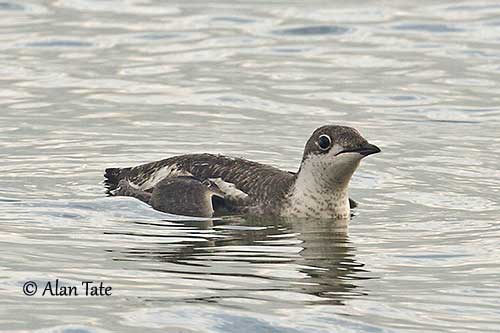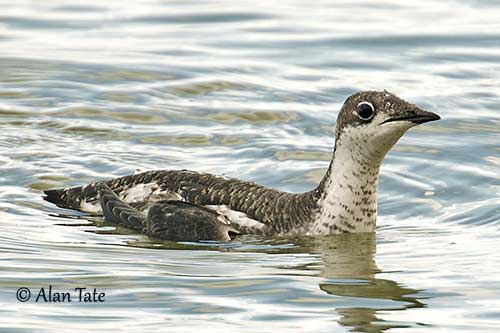
Fr: Guillemot à long bec
Ang: Long-billed Murrelet
All: Langschnabelalk
Esp: Mérgulo jaspeado asiático
Ita: Urietta beccolungo
Nd: Aziatische Marmeralk
Sd: Långnäbbad marmoralka
Photographers:
Alan & Ann Tate
AA Bird Photography
Text by Nicole Bouglouan
Sources:
HANDBOOK OF THE BIRDS OF THE WORLD Vol 3 by Josep del Hoyo-Andrew Elliott-Jordi Sargatal - Lynx Edicions - ISBN: 84873342
What Bird-The ultimate Bird Guide (Mitchell Waite)
Wikipedia, the free encyclopaedia
Ocean Wanderers "Ride the Wave"
Bird Research News Vol.5 No.6. By Yoshihiro FUKUDA - Shiretoko Seabird Society
Body Condition and Survival of Vagrant Long-billed Murrelets, Brachyramphus perdix, in North America
By SPENCER G. SEALY and HARRY R. CARTER
Long-billed Murrelet in Devon: New to Britain by Kevin Rylands
Long-billed Murrelet
Brachyramphus perdix
Charadriiformes Order – Alcidae Family
INTRODUCTION:
The Long-billed Murrelet is found in the North Pacific. Unlike other members of family Alcidae, it often nests in old-growth forests far inland.
It was formerly a subspecies of the Marbled Murrelet (B. marmoratus) until 1998, but it differs by its larger size and plumage colour and pattern.
The Long-billed Murrelet is threatened by the logging of the old-growth forest, especially on Sakhalin Island and the Kamchatka peninsula. This species is currently listed as Near Threatened.
DESCRIPTION OF THE BIRD:
Biometrics:
Length: 24-26 cm
Weight: 227-283 g
The Long-billed Murrelet is a bulky Alcid, with tapered wings and squared tail. The wings have a white band at base.
The adult in summer has spotted or barred buff upperparts, whereas the underparts are pale brown with browner barring and white mottling. Central underparts are mostly white (the part often immerged). Chin and throat are much whiter with scattered, paler brown bars.
On the head, crown, forehead, nape and lores (above the gape) are dark brown. Lower cheek and head sides are white with some pale brown spots.
The pointed blackish bill is relatively long. The eyes are dark brown, surrounded by narrow, white eyering. Legs and feet are greyish.

In winter plumage, the underparts are white whereas crown, nape, wings and back are black, with pale stripes on the latter. It lacks the white collar of the Marbled Murrelet. The dark crown extends below the eye.
Male and female are similar.
The juvenile resembles adult in winter. It has throat and upper breast slightly tinged with grey.
RANGE:
The Long-billed Murrelet breeds from Kamchatka to the Sea of Okhotsk, S to N Japan (Hokkaido). It winters in seas around N Japan, and in the southern part of Sea of Okhotsk. Some birds may reach South Korea and S Japan.
Some rare occurrences are reported throughout North America in autumn and winter, and from Alaska to Florida. A bird was discovered in Devon (Britain) in November 2006.
HABITAT:
The Long-billed Murrelet breeds in old-growth coniferous forests, about 30 kilometres from the seacoast. It also nests on rocky slopes and cliffs, or boulder areas near the ocean.
During winter, it usually occurs in sheltered coastal waters.
It may forage on coastal freshwater lakes on Kamchatka peninsula and Sakhalin Island, within 20 kilometres of ocean. Lakes, rivers, oceans, rocky areas, coniferous and open forests are its preferred habitats.
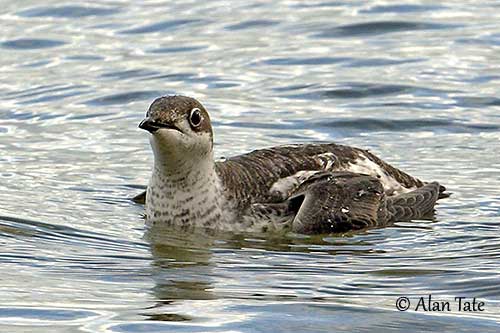
CALLS AND SONGS: SOUNDS BY XENO-CANTO
The Long-billed Murrelet utters a repeated “meer, meer” both in flight and on water. Longer and shriller calls are used as contact between two birds “hifee, hifee”. This call is also heard during the displays between mates.
BEHAVIOUR IN THE WILD:
The Long-billed Murrelet feeds on small fish and crustaceans often found in pelagic offshore waters associated with upwellings that drive the preys close to the surface. It also forages in sheltered bays. It feeds by diving from the surface.
The Long-billed Murrelet has unusual breeding behaviour. Unlike most Alcids, it is mainly solitary nester, with some pairs at low densities in old-growth coniferous forests.
Its selection of such breeding habitat, often at considerable distances inland, is not well understood and requires more information.
They are probably monogamous. During the displays, two birds can be seen swimming side by side and calling each other, while moving their bills up and down. Then, one of them swims around the other. They may dive synchronously, or take flight, and chases are reported.
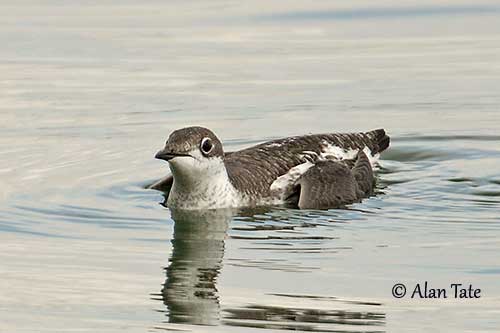
The Long-billed Murrelet is migratory. It leaves its breeding grounds in September/October and moves S to the wintering grounds. It returns to the nesting areas in May.
It is mostly a short-distance migrant, and movements can be nocturnal or diurnal.
The Long-billed Murrelet has strong, fast, powerful flight.
REPRODUCTION OF THIS SPECIES:
In the northern part of the breeding range, the nesting period occurs in late June to late August, while in the southern parts, the nestling period is mainly from early June to late July. Both periods have been estimated while seeing adults carrying food to the chicks.
The Long-billed Murrelet breeds in coniferous and mixed mature forests, in both lowlands and mountains, within 30 kilometres from the seacoast. A few nests have been observed, all built in larch forests. The structure is often built on a pile of branches covered with moss, at about 5-7 metres above the ground. These branches are a very suitable place used as a platform for the nest. The cup-shaped structure is made with twigs, needles and dry leaves.
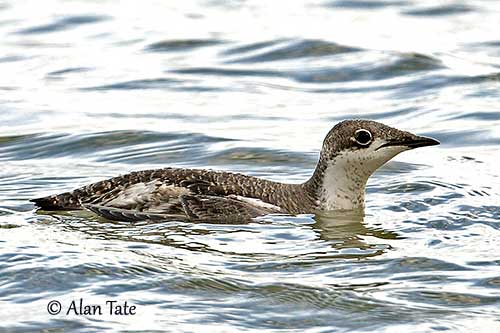
The female lays a single egg and both adults incubate during about 28-30 days with stints of 24 hours. Sharp, shrilling calls can be heard from the flying adult when it returns to the nest.
The chick is fed by both parents. The period may last between 27 and 40 days. It leaves the nest and flies directly to the sea once fledged.
PROTECTION / THREATS / STATUS:
The Long-billed Murrelet is threatened by deforestation on Sakhalin Island and Kamchatka peninsula, and oil industry development on Okhotsk and Bering Seas.
The global population was said to number in the “tens of thousands” in 1995, but it is suspected to be declining rapidly, due to the previous threats.
The Long-billed Murrelet is currently classified as Near Threatened.
